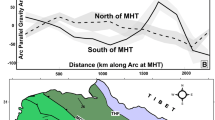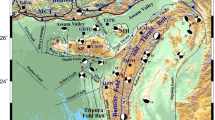Abstract
The foremost Global Positioning System (GPS) derived measurements in the Kumaun Himalaya indicate that most of the crustal motion of the Indian plate is accommodating towards the base as well as on the hanging wall of Main Central Thrust (MCT). Deformation pattern within the Kumaun Himalaya varies from south to north and indicates maximum deformation rate near MCT. Our study, based on the campaign mode GPS survey during 2003–2006, reveals that the area between north of North Almora Thrust (NAT) and at the base of Great Himalaya registers maximum strain rate, which is lowered towards the Trans Himadri Fault (THF). The GAMIT-GLOBK processed campaign data of the area show that currently, the Himalayan Frontal Fault (HFF) and Main Boundary Thrust (MBT) are locked with the Indian plate, and a 6.7 ± 2.5 mm/yr of horizontal shortening is taking place between the Lesser Himalaya and Peninsular India.
Similar content being viewed by others
References
Armijo R, Tapponnier P, Mercier JL, Han TL (1986) Quaternary extension in southern Tibet: field observations and tectonic implications. Journal of Geophysical Research 91(13): 803–872. DOI: 10.1029/JB091iB14P13803.
Avouac JP (2003) Mountain building, erosion and the seismic cycle in the Nepal Himalaya. Advances in Geophysics 46: 1–80. DOI: 10.1016/S0065-2687(03)46001-9
Bilham, R (1995) Location and magnitude of the 1833 Nepal earthquake and its relation to the rupture zones of contiguous great Himalayan earthquakes. Current Science 69: 101–128.
Bilham, R (2004) Earthquakes in India and the Himalaya: tectonics, geodesy, and history. Annals of Geophysics 47(2): 839–858. DOI: 10.4401/ag-3338.
Bilham R, Blume F, Bendick R, Gaur VK (1998) Geodetic constraints on the translation and deformation of India: implications for future great Himalayan earthquakes. Current Science 74: 213–229.
Bilham R, Gaur VK, Molnar P (2001) Himalayan Seismic Hazard. Science 293: 1442–1444. DOI: 10.1126/science.1062584.
Chen Z, Burchfiel BC, Liu Y, King RW, Royden LH, Tang W, Wang E, Zhao J, Zhang X (2000). Global Positioning System measurements from eastern Tibet and their implications for India/Eurasia intercontinental deformation. Journal of Geophysical Research 105(B7): 16215–16227. DOI: 10.1029/2000JB900092.
Gansser A (1964) Geology of the Himalaya. Interscience, NewYork, USA. p 289.
Godin, L (2003). Structural evolution of the Tethyan sedimentary sequence in the Annapurna area, central Nepal Himalaya. Journal of Asian Earth Science 22: 307–328. DOI: 10.1016/S1367-9120(03)00066-X.
Herring T, King RW, McClusky SC (2006) GAMIT Reference Manual. GPS Analysis at MIT, Release 10.3, Department of Earth, Atmospheric and Planetary Sciences, Massachusetts Institute of Technology Cambridge. p 36.
Jade S, Bhatt BC, Bendick R, Gaur VK, Molnar P, Anand MB, Kumar D (2004) GPS measurements from the Ladakh Himalaya, India: tests of plate-like or continuous deformation in Tibet. Geological Society of America Bulletin 116: 1385–1391. DOI: 10.1130/B25357.1
Jaeger JC (1969) Elasticity, Fracture and Flow. Methuen, London, UK. p 268.
Jhingran AG, Thakur VC, Tandon SK (1976) Structure and tectonics of the Himalaya, Misc. Publ. Geological Survey of India (41): 1–36.
Khattri KN, Tyagi AK (1983) The transverse tectonic features in the Himalaya. Tectonophysics 96: 19–29. DOI: 10.1016/0040-1951(83)90241-X.
King RW, Bock Y (1998) Documentation for the GAMIT GPS processing software release 10.0, Massachusetts Institute of Technology, Cambridge, USA. p 172.
Molnar P, Lyon-Caen H (1989) Fault-plane solutions of earthquakes and active tectonics of the Tibetan plateau and its margins. Geophysical Journal International 99: 123–153. DOI: 10.1111/j.1365-246X.1989.tb02020.x
Molnar P, Tapponnier P (1975) Cenozoic Tectonics of Asia: Effects of a continental collision. Science 189: 419–426. DOI: 10.1126/science.189.4201.419.
Pant CC, Paul A (2007) Recent Trends in Seismicity of Uttaranchal. Journal of Geological Society of India 70: 619–626.
Patriat P, Achache J (1984) India-Eurasia collision chronology has implications for crustal shortening and driving mechanism of plates. Nature 311: 615–621. DOI: 10.1038/311615a.
Paul A, Bhakuni SS, Pant CC, Darmwal GS, Pathak V (2010) Microseismicity in central part of Inner Kumaun Lesser Himalaya: Implication to active seismotectonics. Himalayan Geology 31(2): 107–115.
Paul J, Bürgmann R, Gaur VK, Bilham R, Larson KM, Anada MB, Jade S, Mukul M, Anupama TS, Satyal G, Kumar D (2001) The Motion and active deformation of India. Geophysical Research Letters 28: 647–651. DOI: 10.1029/2000GL011832.
Paul SK (1998) Geology and tectonics of the Central Crystallines of northeastern Kumaon Himalayas, India. Journal of Nepal Geological Society 18: 151–167.
Ponraj M, Miura S, Reddy CD, Amrithraj S, Mahajan SH (2011) Slip distribution beneath the Central and Western Himalaya inferred from GPS measurements. Geophysical Journal International 185: 724–736. DOI: 10.1111/j.1365-246X.2011.04958.x.
Ponraj M, Miura S, Reddy CD, Prajapati SK, Amirtharaj S, Mahajan SH (2010) Estimation of strain distribution using GPS measurements in the Kumaun region of Lesser Himalaya. Journal of Asian Earth Sciences 39 (6): 658–667. DOI: 10.1016/j.jseaes.2010.04.019.
Rowley DB (1996) Age of initiation of collision between India and Asia: A review of stratigraphic data. Earth and Planetary Science Letters 145: 1–13. DOI: 10.1016/S0012-821X(96)00201-4.
Seeber L, Armbruster JG (1981) Great detachment earthquakes along the Himalayan arc and long-term forecasting. In: Simpson DE, Richards PG (Eds.), Earthquake Prediction: An International Review. American Geophysical Union, Washinguton. pp 215–242.
Shen Z-K, Jackson DD, Ge BX (1996) Crustal deformation across and beyond the Los Angeles basin from geodetic measurements. Journal of Geophysical Research 101(B12):27957–27980. DOI: 10.1029/96JB02544.
Sinha AK (1989) Geology of the Higher Central Himalaya. John Willy & Sons, Chichester, UK. p 236.
Srivastava P, Mitra G (1994) Thrust geometries and deep structure of the outer and lesser Himalaya, Kumaon and Garhwal (India): Implications for evolution of the Himalayan fold-and-thrust belt. Tectonics 13(1): 89–109. DOI: 10.1029/93TC01130.
Thakur VC (1992) Geology of the western Himalaya. Pergmon press, Oxford and New York. p 355.
Valdiya KS (1979) An outline of the structural set-up of Kumaun Himalaya. Journal of Geological Society of India 20: 145–157.
Valdiya KS (1980) Geology of the Kumaun Lesser Himalaya, Dehradun, India. Wadia Institute of Himalayan Geology. p 291.
Valdiya KS (1999) Fast uplift and geomorphic development of the western Himalaya in Quaternary period. Memoir of Gondwana Research Group 6: 179–187.
Wang Q, Zang P, Freymueller JT, Bilham R, Larson KM, Lai X, You X, Niu Z, Wu J, Li Y, Yang Z, Chen Q (2001). Present day crustal deformation in China constrained by Global Positioning System measurements. Science 294: 574–577. DOI: 10.1126/science.1063647.
Weber J, Stein S, Engeln J (1998) Estimation of intraplate strain accumulation in the New Madrid seismic zone from repeat GPS surveys. Tectonics 17: 250–266. DOI: 10.1029/97TC03550.
Zhang P, Shen Z, Wang M, Gan W, Burgmann R, Molnar P, Wang Q, Niu Z, Sun J, Wu J, Hanrong S, Xinzhao Y (2004) Continuous deformation of the Tibetan Plateau from global positioning system data. Geology 32(9): 809–812. DOI: 10.1130/G205541.
Author information
Authors and Affiliations
Corresponding author
Rights and permissions
About this article
Cite this article
Dumka, R.K., Kotlia, B.S., Kumar, K. et al. Crustal deformation revealed by GPS in Kumaun Himalaya, India. J. Mt. Sci. 11, 41–50 (2014). https://doi.org/10.1007/s11629-012-2552-x
Received:
Accepted:
Published:
Issue Date:
DOI: https://doi.org/10.1007/s11629-012-2552-x




